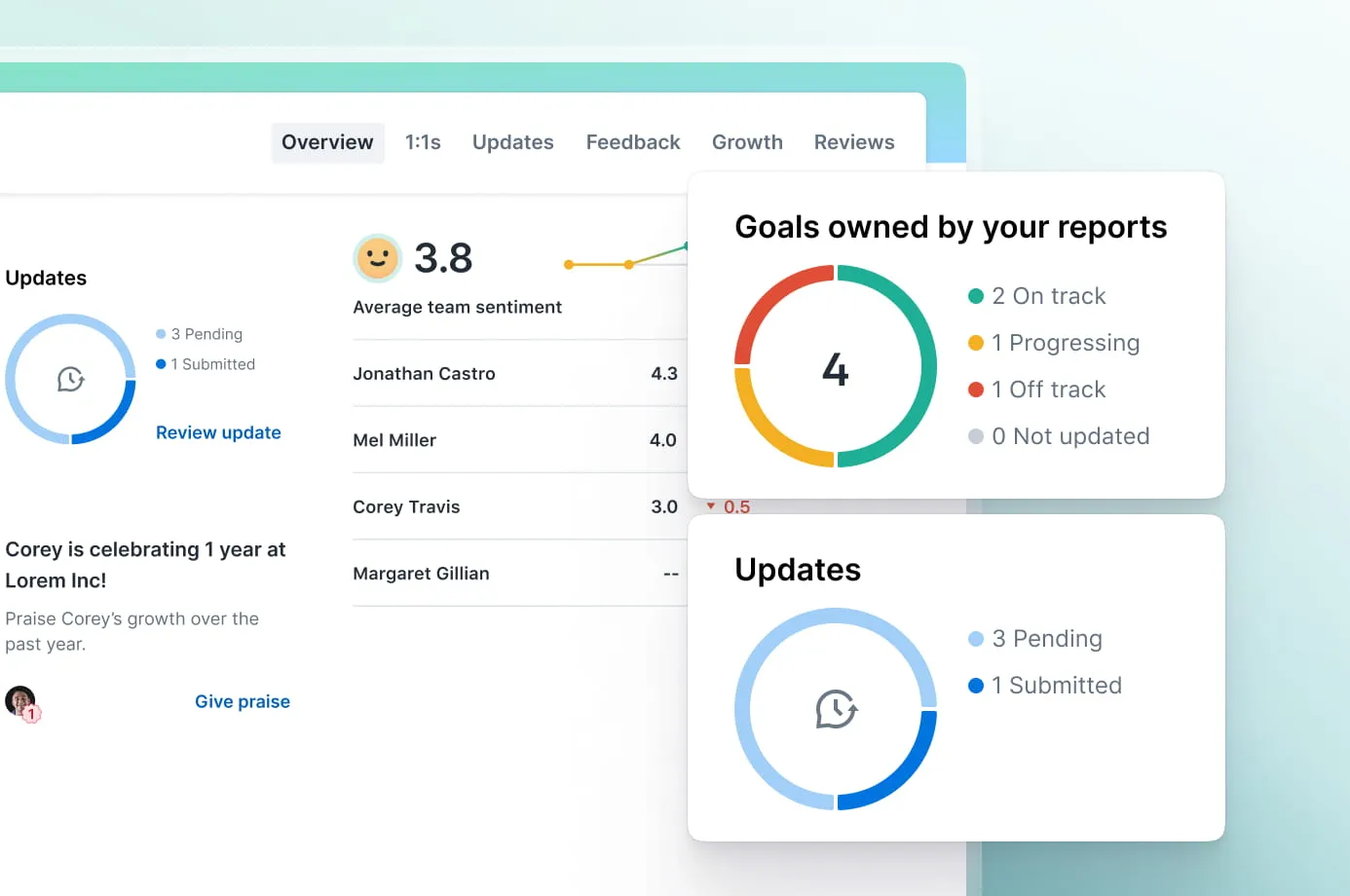Performance appraisals and manager one-to-ones are both key to an effective performance management process. But they’re not always used in the most effective way — and to get the best of both, they need to be treated as distinct, if related, activities that provide a direction of travel for employee performance and growth goals.
If managers use performance appraisal meetings to simply repeat feedback from weekly one-to-ones, they can become a redundant checkbox activity. Similarly, weekly one-to-ones can quickly become a chore for line managers and direct reports alike. And if they do, then busy managers may feel inclined to cancel these meetings altogether, negatively affecting employee growth.
To create a performance appraisal process that is genuinely useful for employees and managers alike, weekly one-to-ones and performance evaluations should be designed to complement each other, and create an actionable, holistic roadmap for performance that takes in short- and long-term goals.
And to make that happen, managers will need the right resources and information at their fingertips.
In this article, we’ll look at how human resources leaders and managers can create better one-to-ones and performance appraisals that reinforce employee engagement, inspire growth, and increase retention.
How Performance Appraisals Support Employee Engagement
According to Gallup’s latest State of the Global Workplace report, today’s workers are stressed, depressed, and living for the weekend. Just 21% of respondents say they’re actively engaged at work, and only one in three would describe themselves as thriving.
Performance review processes — both informal weekly manager catch-ups, and more structured performance appraisals — can have a transformational impact on employee engagement. In fact, Gallup research also shows that managers in general account for a whopping 70% of employee engagement levels. And when employees are engaged, they’re more likely to perform at their best.
So, creating a high performing and engaged team depends on building constructive feedback systems and processes that enable managers to effectively communicate with their direct reports.
Effective performance management discussions — whether these are informal weekly one-to-ones or formal performance appraisals — provide managers with opportunities to reinforce their direct reports’ sense of purpose and progress, strengthen their relationship and help them to build their professional strengths. This results in higher levels of engagement and motivation.
However, one-to-ones and performance appraisals fulfil very different purposes. Great managers know how to make the most of both to help keep their team members motivated, aligned, and engaged.
One-to-Ones and Performance Appraisals: What’s the Difference?
One-to-ones and performance appraisals are both feedback-driven processes that share similar overall goals. Both aim to support employee career development, foster connection and alignment between the manager and the employee, and provide an opportunity for feedback and praise. Both should be bi-directional, and encourage an ongoing conversation.
And both should aim to ensure employee retention by identifying and addressing issues, facilitating optimal performance, and providing the employee with the opportunity for professional development and career growth.
However, they have notable differences in tone and focus.
Tim Reitsma, general manager at People Managing People, explains: “One-to-ones are less about getting tasks checked off, and more about ‘How are things going?’ and ‘How can I support you to do your best work?’ These meetings serve as a gateway to connect, learn about each other, clarify responsibilities and accountabilities and provide feedback.
“A great performance appraisal includes a mechanism on how well someone is doing, what might need to improve and a conversation about the future. Using this time as a way to give and receive feedback is key.”
How One-to-Ones and Performance Appraisals Fit Together
In an ideal scenario, the feedback, discussion of key competencies, and goal-setting that takes place during regular one-to-ones should inform individual performance appraisals. In other words, managers can use data gathered during manager-employee one-to-ones to build a more comprehensive employee performance review.
By the time performance appraisal season comes, managers can review their notes and the data gathered during weekly one-to-ones to inform and update their performance reviews with details such as:
- Changing employee career aspirations
- Regular or emerging roadblocks and challenges
- Learning opportunities and needs
- Project achievements
Treating appraisals as dynamic, evolving, and malleable touch points for employee growth can help the experience feel more meaningful to employees and less redundant to managers.

Benefits of Linking One-to-Ones with Appraisals
Having the right tools and processes in place means managers can take data from weekly one-to-ones and translate it into a longer-term plan when the performance review rolls around — and that can add up to some significant benefits:
1. Reduce rater bias.
Performance appraisals are notoriously riddled with manager bias. Even the best-intentioned manager may simply forget examples of outstanding (or subpar) past performance that occurred earlier in the year, and focus their performance feedback on recent events (also known as recency bias). But when the manager has their notes from one-to-ones to hand, they can review the employees’ work since their last performance appraisal more easily. This helps them give a more balanced and actionable appraisal.
2. Give employees an overview of their progress.
Employees are highly motivated when they have a sense of career development.By using data from one-to-ones to inform their performance appraisals, managers can help their direct reports chart their progress and appreciate how their current role has fostered their professional development. In turn, employees are two times more likely to remain in a role where they can see they are progressing towards their career goals.
3. Stay focused on employee development.
By tying one-to-one feedback and discussion into the broader context of the employee’s overall performance, managers can keep their direct reports’ progress top of mind on a weekly basis — not just once or twice a year at performance review time. This is important, because otherwise busy managers may not prioritise their employees’ development as part of the day-to-day. And as we found out in our recent Career Progression Survey, that means employees may feel a lack of mentorship, or feel ignored by their manager, which is linked to decreased motivation.
4. Connect short-term individual goals to long-term company objectives.
By connecting the notes and outcomes of weekly one-to-ones to performance reviews, managers can show their direct reports that their job performance ties into the overall company mission. This helps foster a greater sense of purpose and that ties directly into employee engagement and retention.
5. Reduce appraisal stress.
When it comes to performance appraisals, employees are most likely to become emotional if they’re shocked by the feedback they received. This might explain why as many as 25% of men (and 18% of women) have been driven to tears by a performance review. However, if feedback has been delivered on an ongoing basis during weekly, performance-focused one-to-ones, performance appraisals contain no nasty surprises. Rather, they function as a review of the big picture and a chance to plan future opportunities for growth.
What Managers Need from HR to Improve One-to-Ones and Appraisals
HR teams must ensure that managers have the tools and training to give great one-to-ones and powerful performance appraisals. Here’s how to do it:
1. Provide the questions to ask.
As the focus of one-to-ones and performance appraisals are different, the questions managers should be asking need to be different, too.
One-to-ones are more frequent, and focused on short-term goals, so managers should be asking employees about their recent achievements, priorities and challenges. They should give employees opportunities to provide feedback, ask for help, identify the need for additional learning, and brainstorm solutions to challenges.
Reitsma suggested asking the following questions for more effective manager one-to-ones:
- How was your progress on the actions we discussed in the last meeting?
- What is top-of-mind for you right now at work?
- Where are you at with the X project / Y task / Z goal?
- What obstacles or barriers to success/completion are you running into?
- Are you on track to meet your deadlines this week?
- Do you have any thoughts, ideas, or suggestions on how to solve this problem?
Performance appraisals may tread similar ground, but have a more strategic and less tactical focus. Performance review questions should invite employees to consider their own performance within the big-picture context, make a note of their progress, share overall career ambitions, and also provide their manager with insight into what they would find motivating and engaging in the future.
It’s also important that employees feel they can provide their managers with feedback. “The only way to make a performance appraisal insightful is to have a two-way conversation," Reitsma said. "If it's simply a one-way conversation, I question how likely the person receiving the information is actually engaged.”
Reitsma recommended asking the following questions during a performance review:
- What have you been most proud of over the past x time period?
- What could have gone better and why?
- What did you want to get done in the past x time period but didn't?
- What is motivating you these days?
- How am I unintentionally getting in your way?
- Where do you think I am succeeding in my role?
- What aspect(s) of my job do you think I can be better at?
2. Enable access to one-to-one notes and performance feedback.
When performance appraisal time rolls around, managers will need easy access to their notes from employee one-to-ones, data on any changes to their employees’ role or responsibilities, critical incidents, peer review information, and so on. Without a unified source of information on their direct reports’ performance, busy managers will inevitably fall back on their memories to prepare performance reviews.
3. Provide training on how to give feedback.
Giving constructive feedback isn’t easy. According to research on feedback published in the Harvard Business Review, 44% of managers find giving negative feedback difficult and stressful, and 21% avoid it altogether.
What’s more, the same study found that negative feedback isn’t particularly useful in improving performance. In fact, employees find manager feedback far more useful when it focuses on their strengths, rather than their weaknesses.
Instead of telling their direct report what they’re doing wrong, leadership coaches Peter Bregman and Howie Jacobson advise managers to act as “allies instead of critics”, and provide empathy and support.
Managers need to help their direct reports to envision the outcome they’re trying to achieve, and then coach them through how to achieve those aims. They should express confidence in their report’s ability to deliver the results they want, and ask what help they need to make it happen.
Great One-to-Ones Lead to Valuable Performance Appraisals
If managers have the performance data, resources, training, and easy-to-access information they need, they’re better equipped to implement a holistic performance management strategy that nurtures engagement, growth and performance.
Engaging one-to-ones will inform inspiring performance appraisals. Employees will be able to see their progress, feel fairly evaluated, and understand how their efforts contribute to the team as a whole. As Reitsma says: “When we have trust and a safe space, both leader and employee can grow together.”








